These Creamy Vegan Miso Mushrooms are not just a dish; they are a culinary experience that will utterly transform your perception of plant-based cooking. Incredibly rich, deeply savory, and brimming with umami, this 30-minute recipe proves that dairy-free can be exceptionally decadent. Even skeptics of mushrooms often find themselves converted into ardent fans after just one bite of these luxuriously saucy fungi.
The secret lies in our robust, dairy-free garlic miso sauce. It’s so irresistibly good that I frequently double the batch, ensuring there’s plenty to drizzle generously over every element on my plate. Imagine this exquisite sauce coating perfectly cooked mushrooms, ready to elevate your meal. This versatile miso mushroom recipe is an ideal companion for garlicky broccolini and fluffy white rice, creating a wholesome and satisfying meal. For those seeking a lower-carb option, it pairs beautifully with a simple cauliflower rice.
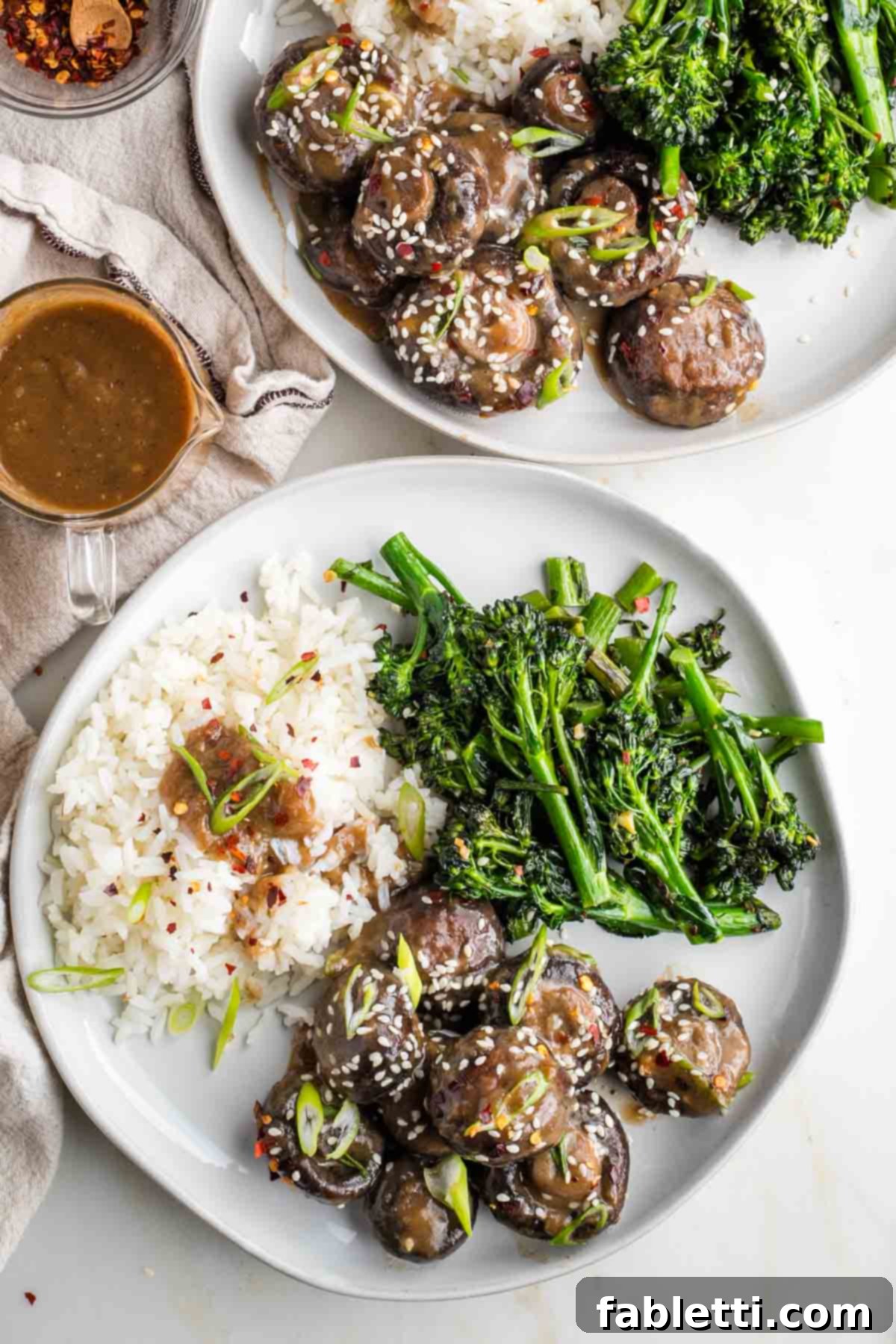
The Ultimate Vegan Miso Mushroom Recipe
Prepare to delight your taste buds, mushroom lovers! This is, without a doubt, the BEST Miso Mushroom Recipe you’ll encounter. What makes it truly exceptional is its wholesome approach: it’s entirely dairy-free, and there’s no need for vegan butter. Instead, we harness the power of whole-food ingredients to achieve an extraordinary depth of flavor. These saucy mushrooms rival, and often surpass, any miso butter mushroom dish you might have tasted, offering a truly gourmet experience that’s both healthy and satisfying.
This recipe isn’t just easy; it’s a testament to how simple ingredients can create complex and unforgettable flavors. Whether you’re a seasoned vegan or simply looking to incorporate more plant-based meals into your diet, this dish offers a convenient, quick, and incredibly tasty solution. Its umami-rich profile makes it a standout, perfect as a versatile side dish or the star of your next plant-based dinner.
Key Ingredients for Miso Mushrooms and Smart Substitutions
Crafting the perfect Creamy Vegan Miso Mushrooms starts with selecting high-quality ingredients. Each component plays a crucial role in building the layered, umami-rich flavor profile that defines this dish. Here’s a detailed look at what you’ll need and how you can adapt it to your pantry and preferences.
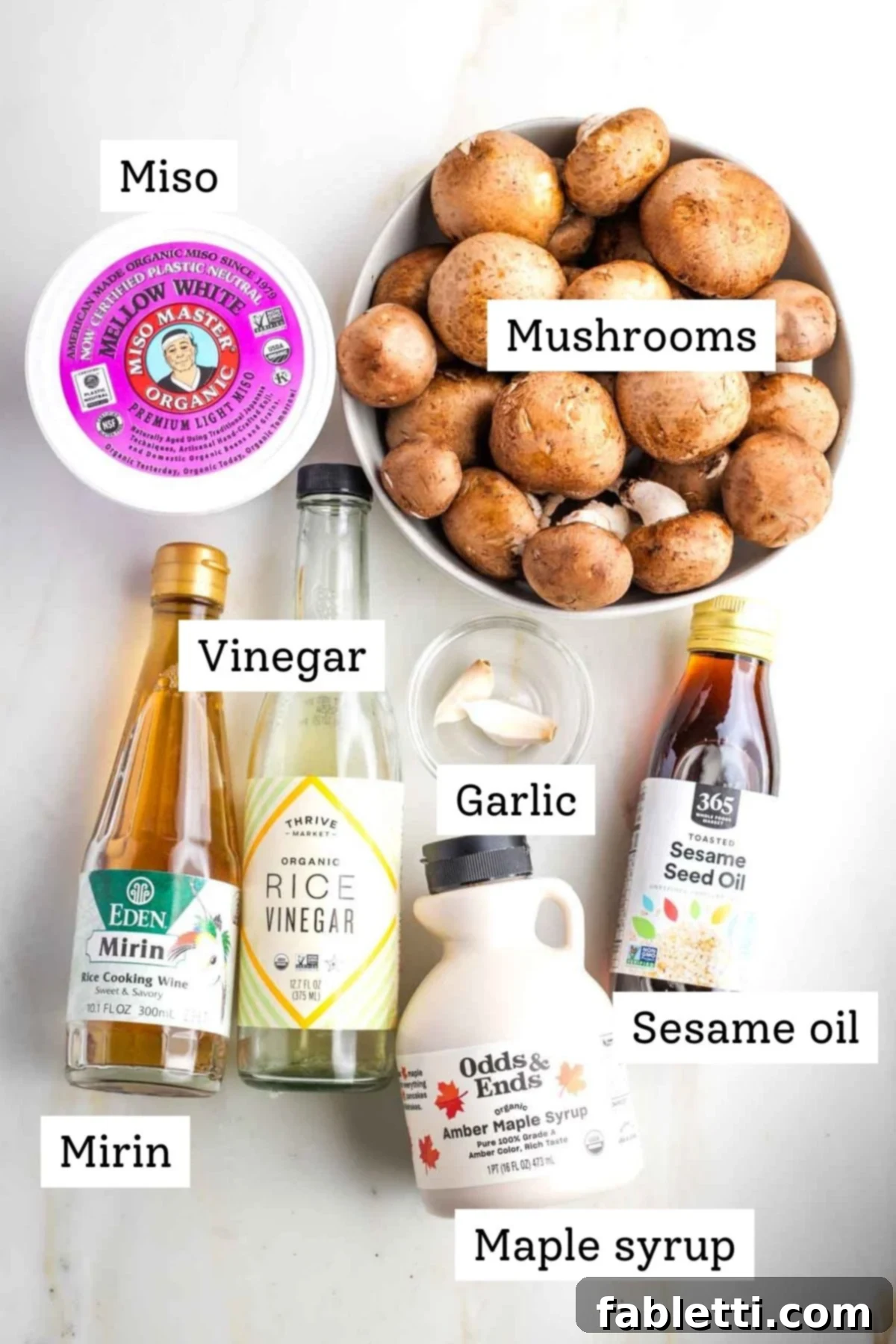
- Mushrooms: Cremini mushrooms, often labeled as baby portobello, are my go-to choice for this recipe due to their earthy flavor and firm texture, which holds up beautifully to the rich sauce. However, feel free to experiment with other varieties. Japanese mushrooms like maitake or shiitake mushrooms offer distinct textures and intense umami. Chestnut mushrooms or king oyster mushrooms are also fantastic options, providing a meaty bite and soaking up the flavors wonderfully if you can source them. Freshness is key, so choose mushrooms that are firm and free from blemishes.
- Miso Paste: The cornerstone of this dish’s umami. I personally prefer a mellow white miso paste for its balanced flavor that enhances without overpowering. Yellow miso paste offers a slightly bolder taste, while red miso paste is the most assertive and salty, perfect if you desire a deeper, more intense umami. Any of these will work beautifully; choose based on your preference for intensity. South River Miso, for example, produces excellent miso varieties from various grains and legumes, including a delightful chickpea miso. Ensure your miso paste is fresh for the best flavor.
- Mirin: This sweet Japanese cooking wine is crucial for adding a subtle sweetness and glaze to Asian dishes. You’ll likely find it in the international aisle of your local grocery store. For convenience, Mirin is also available online. If you don’t have mirin, a dry sake, another sweet white wine, or even apple juice can be used as a substitute, though the flavor profile will be slightly different.
- Rice Vinegar: This acidic component is vital for balancing the salty notes of the miso and the sweetness of the mirin and maple syrup. It brightens the overall flavor and prevents the dish from tasting flat. Opt for an unsweetened brand of rice vinegar. Suitable substitutes include fresh lemon juice, apple cider vinegar, or distilled white vinegar.
- Maple Syrup: A touch of pure maple syrup not only adds a lovely sweetness but also aids in the caramelization process of the mushrooms, enhancing their flavor and giving them a beautiful glossy finish. If you prefer a less sweet sauce or find the natural sweetness from the miso and mirin sufficient, you can reduce the amount or omit it entirely. Agave nectar is another viable vegan sweetener option.
- Toasted Sesame Oil: The deep, nutty aroma and flavor of toasted sesame oil are indispensable for authentic Asian flair. It adds a layer of complexity and warmth to the sauce. If you prefer a no-oil mushroom recipe, you can skip it, but note that the flavor profile will be less rich. Olive oil can be used as a neutral substitute for cooking the mushrooms if you still desire some fat for sautéing, but it won’t provide the same distinctive flavor.
- Garlic: Freshly grated garlic cloves offer the most pungent and aromatic flavor. Grating ensures it disperses evenly throughout the sauce. If fresh garlic isn’t available, garlic powder can be used (ensure it’s not garlic salt, as miso already provides ample sodium). As a general rule, 1/4 teaspoon of garlic powder equals one clove of fresh garlic.
- Optional Garnishes: To add a final flourish of flavor and visual appeal, consider sprinkling your finished dish with thinly sliced green onions (scallions), toasted sesame seeds for crunch, or a pinch of crushed red pepper flakes for a subtle kick. Fresh cilantro or parsley can also add a burst of freshness.
Mastering Creamy Vegan Miso Mushrooms: A Step-by-Step Guide
Creating these delightful Miso Mushrooms is a straightforward process that yields incredibly flavorful results. We’ll begin by preparing the aromatic garlic miso sauce, allowing the mushrooms to soak up its rich essence before cooking. This ensures every bite is infused with savory goodness.

Step 1: Whisk the Miso Sauce. In a small bowl or a Pyrex measuring cup, combine the miso paste, rice vinegar, mirin, maple syrup, and toasted sesame oil. These are the core components of our umami-packed marinade. Using a measuring cup makes it easy to pour later.
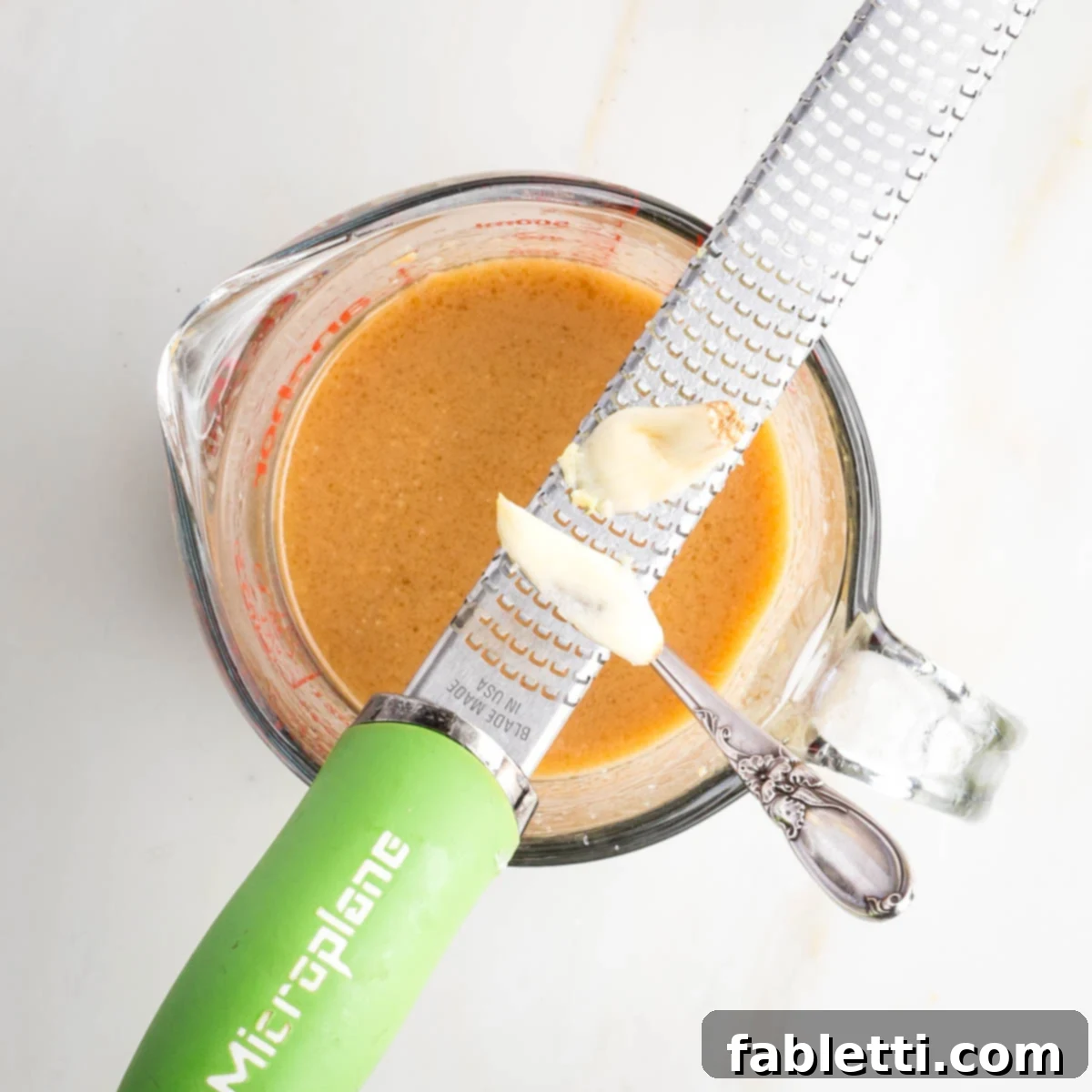
Step 2: Combine and Infuse. Mix these ingredients thoroughly with a fork, ensuring all clumps of miso paste are smoothed out. The goal is a uniform, creamy consistency. Next, grate the fresh garlic directly over the mixture. The fine grating helps release maximum flavor and integrate it seamlessly into the sauce. Mix well again, ensuring the garlic is evenly distributed.
Prepare Your Mushrooms for Perfection
Proper mushroom preparation is key to avoiding soggy results and maximizing flavor absorption:
- Cleaning: Take a moment to gently clean your mushrooms. Use a slightly damp paper towel or a soft brush to carefully wipe away any dirt or debris from their surfaces. Avoid washing mushrooms under running water or soaking them, as they are like sponges and will absorb excess liquid, leading to a watery texture when cooked.
- Trimming: Inspect the stems. If they appear tough, dry, or damaged, simply take a very thin slice off the end. For larger mushrooms or if the stems are significantly damaged, you can break them off entirely. The cap is where most of the meaty texture and flavor reside.
- Slicing (Optional): For even cooking and easier eating, you can slice larger mushrooms into uniform pieces. Smaller cremini mushrooms can be left whole or halved.

Step 3: Marinate the Mushrooms. Place your meticulously cleaned and trimmed mushrooms into a medium-sized bowl. Pour the prepared garlic miso sauce evenly over the mushrooms. Ensure all surfaces are coated.
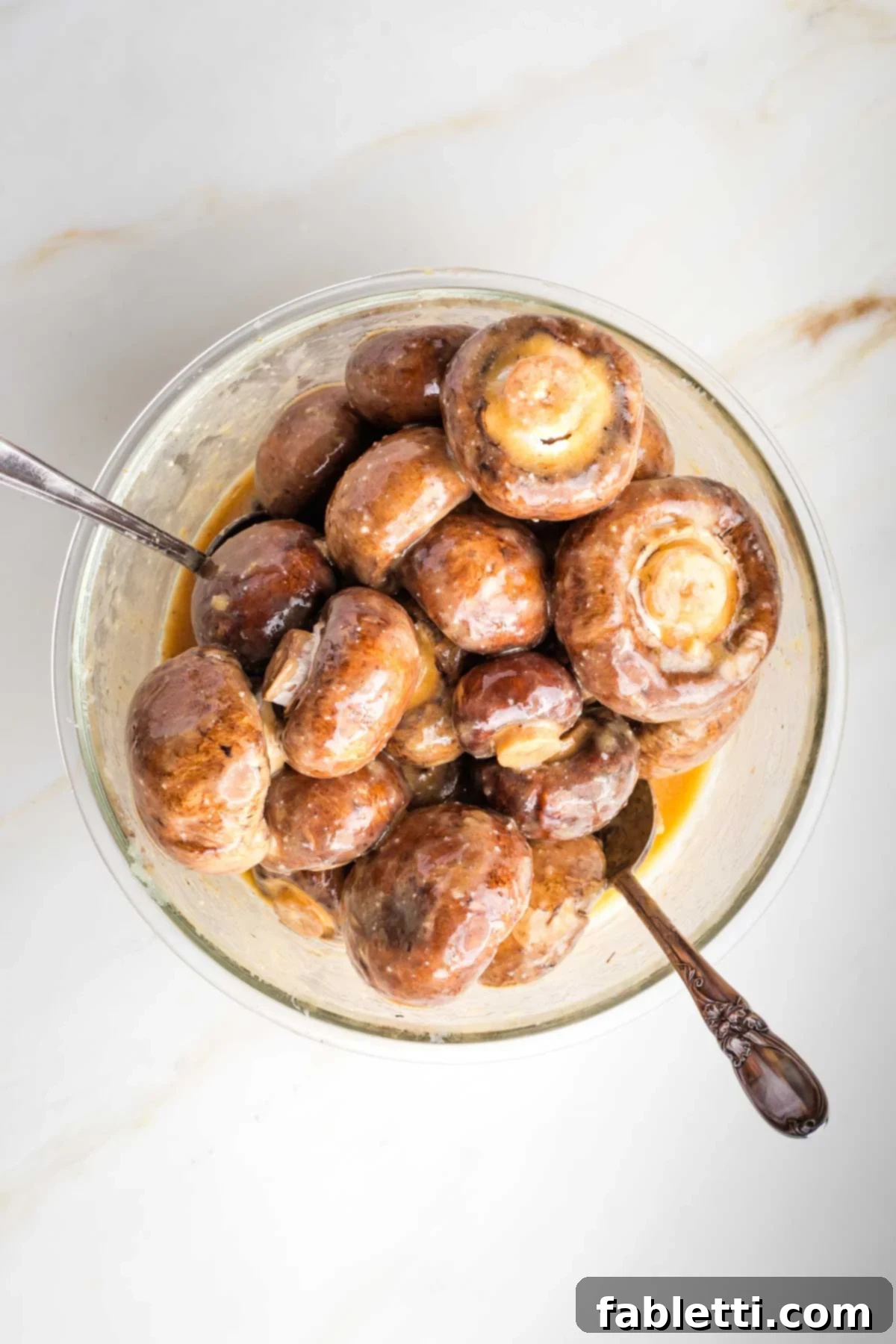
Step 4: Gentle Coating. Using a spoon or your hands, gently toss the mushrooms, making sure each one is thoroughly coated with the flavorful garlic miso sauce. Handle them with care to avoid breaking the delicate mushroom caps. Allow them to marinate for at least 15 minutes. This brief marination period is crucial for the mushrooms to absorb the rich flavors of the sauce, resulting in a more profound taste.
Step 5: Heat the Skillet. Heat a large skillet over medium heat. A cast iron skillet is an excellent choice for achieving beautiful caramelization and even cooking. However, if you opted for a no-oil recipe, a good quality non-stick frying pan would be more suitable to prevent sticking. If using oil, add a tablespoon of neutral oil to the pan now.
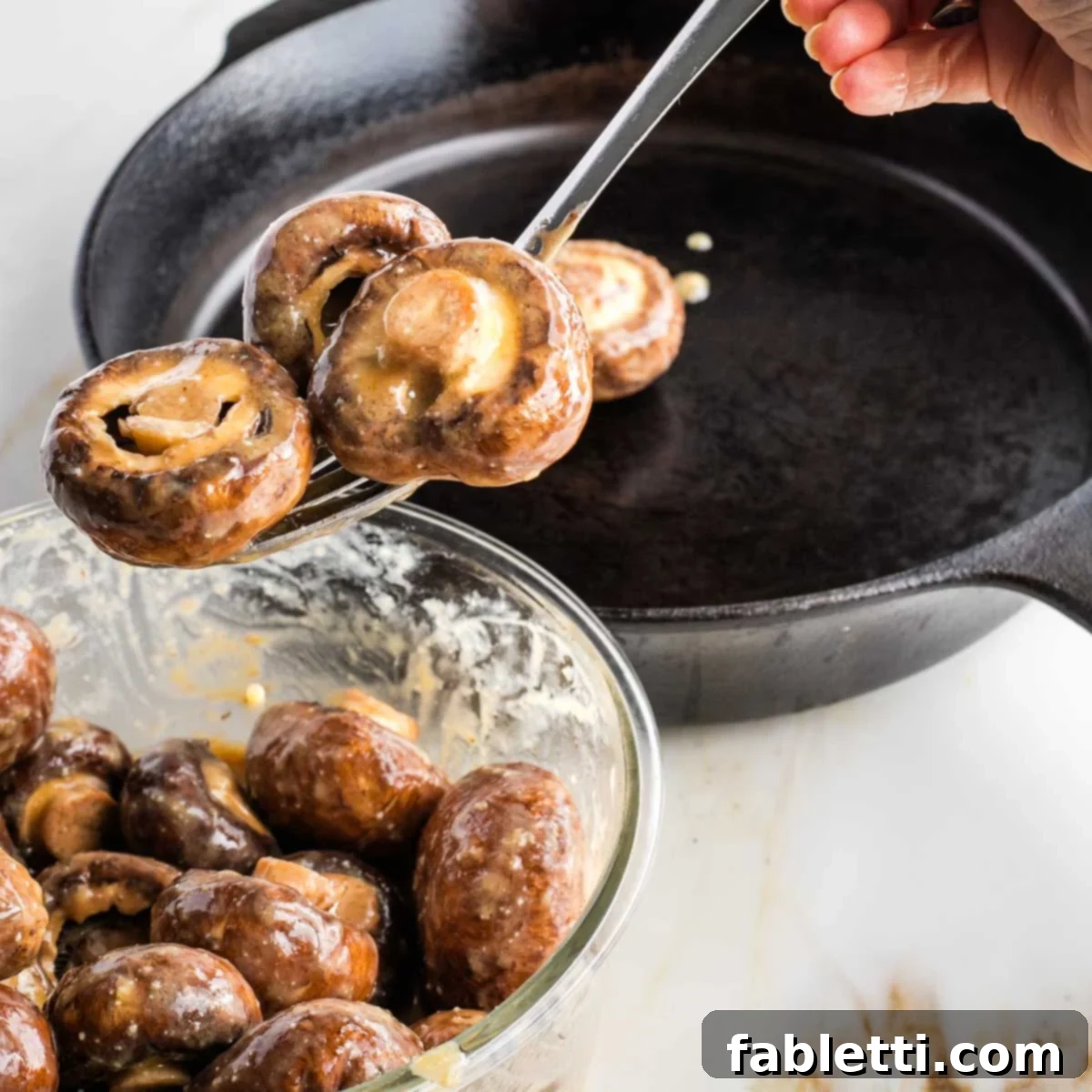
Step 6: Initiate Cooking. Using a slotted spoon, carefully transfer the marinated mushrooms to the hot pan, leaving any excess marinade in the bowl for now. This allows the mushrooms to sear and develop a lovely brown crust without immediately stewing in too much liquid.

Step 7: Sauté and Deglaze. Sauté the mushrooms, stirring frequently with a wooden spoon, for about 3 minutes. During this time, they will begin to release their natural moisture and start to brown. While they are cooking, add ¼ cup of water to the remaining marinade in the bowl. This creates a flavorful liquid to deglaze the pan and finish cooking the mushrooms. Pour this diluted sauce over the cooking mushrooms.
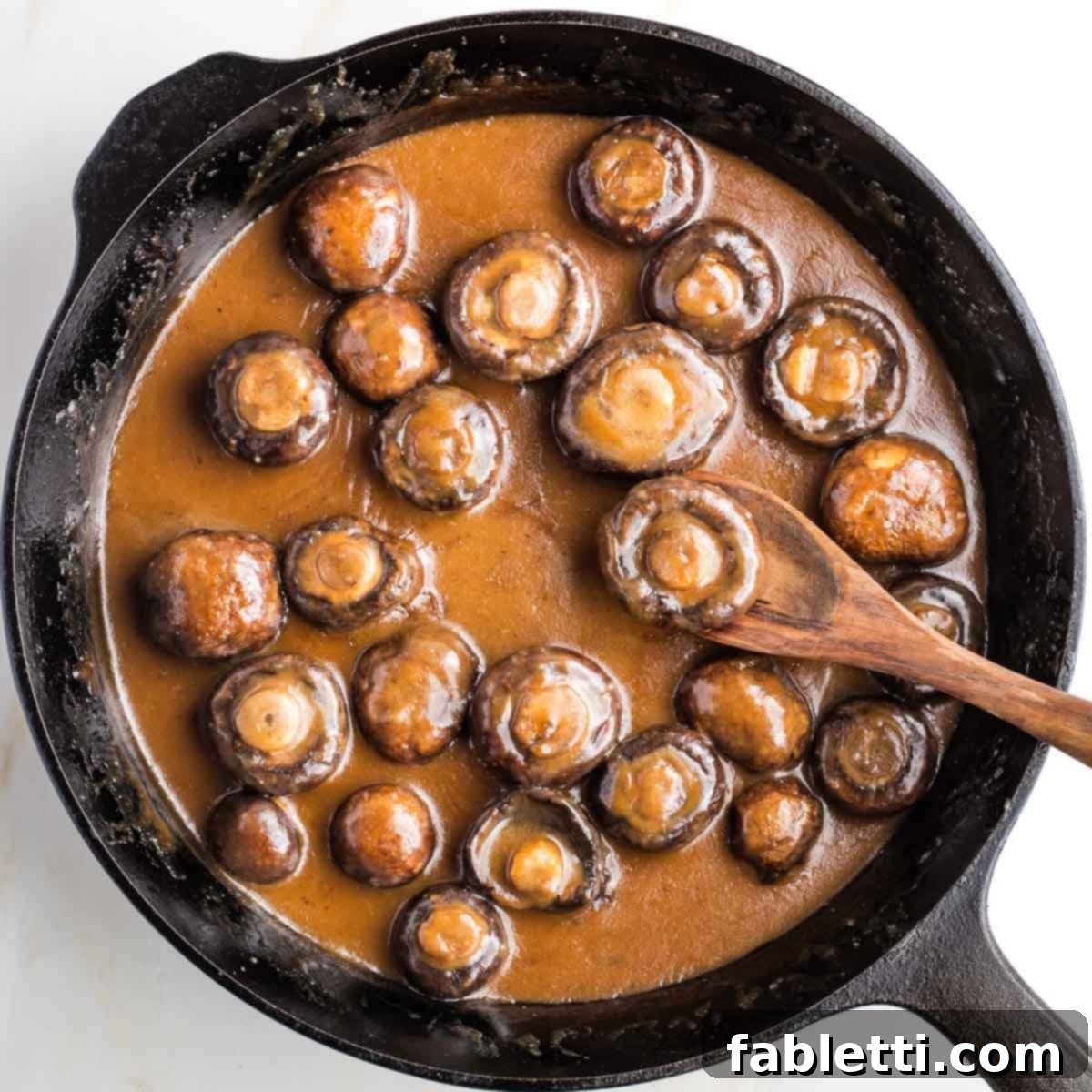
Step 8: Simmer to Perfection. Stir carefully, gently spooning the sauce over the mushrooms occasionally to ensure even coating and cooking. Continue to cook for another 5-7 minutes, or until the mushrooms are tender when pierced with a fork and the sauce has thickened beautifully. The cooking time may vary slightly depending on the size and variety of mushrooms you are using. They will shrink considerably as they cook, concentrating their flavors.
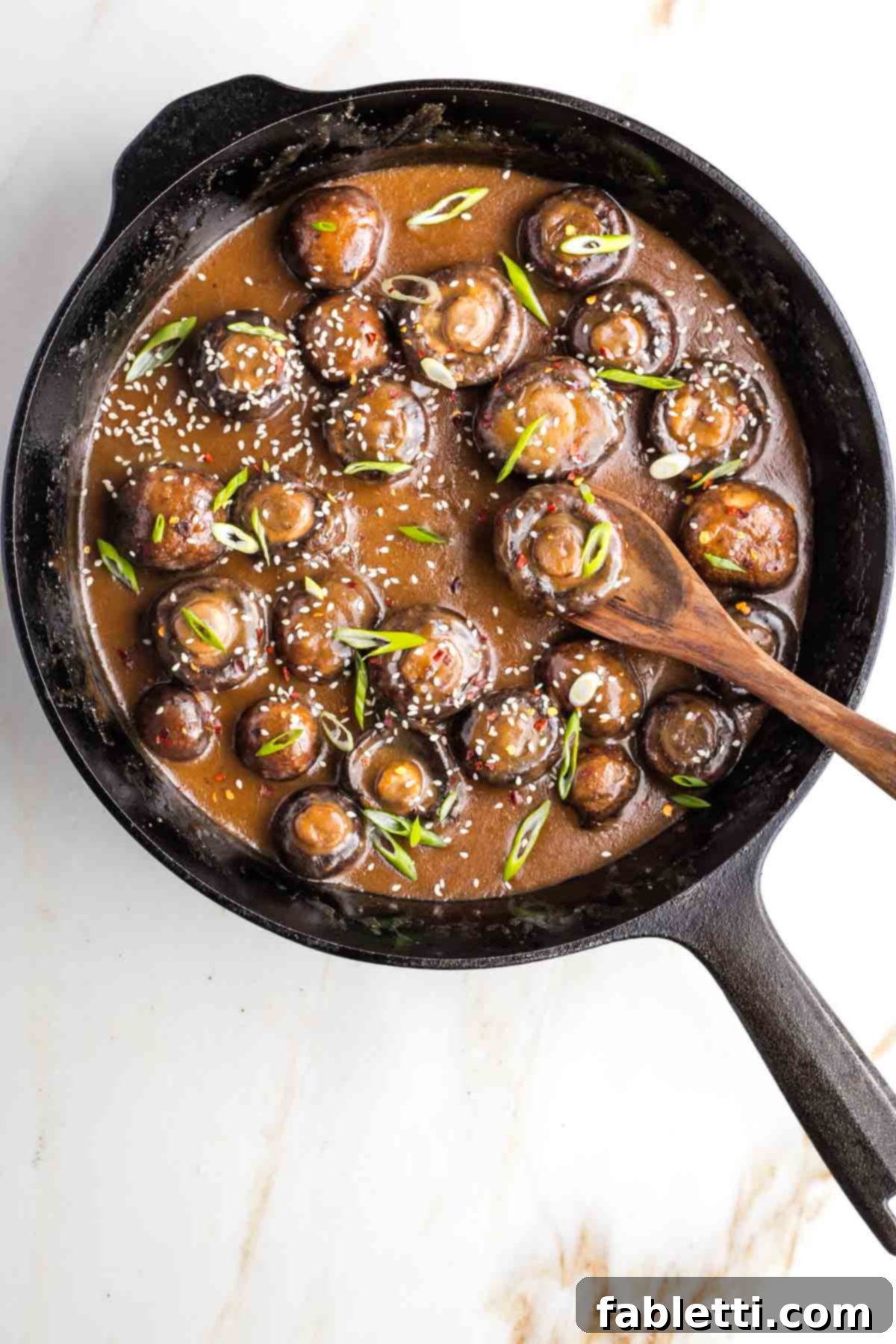
Step 9: Finish and Garnish. Once cooked, use a slotted spoon to transfer the tender, saucy mushrooms to a serving bowl or platter. If you desire a thicker sauce, increase the heat to medium-high and allow the remaining sauce in the skillet to reduce slightly for a minute or two, stirring constantly. This intensifies its flavor and creates a more luxurious consistency.
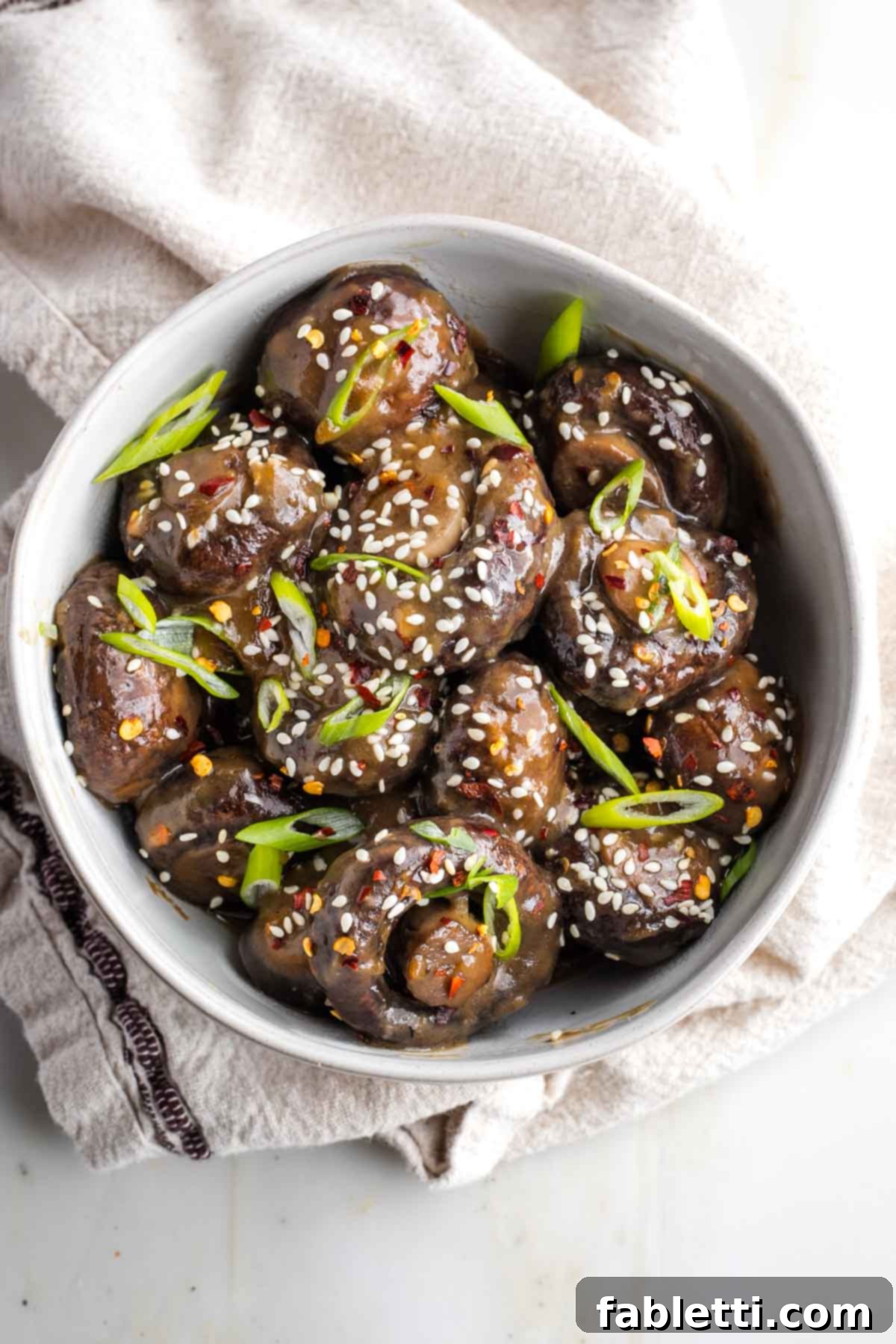
Step 10: Serve Warm. Generously spoon any extra, reduced miso sauce over the mushrooms. Garnish as desired with fresh green onions, sesame seeds, or red pepper flakes for an extra pop of flavor and visual appeal. Serve immediately and enjoy the incredible umami explosion!

Expert Tips for the Best Vegan Miso Mushrooms
Unlock the full potential of this recipe with these professional insights, designed to elevate your dish from delicious to truly unforgettable.
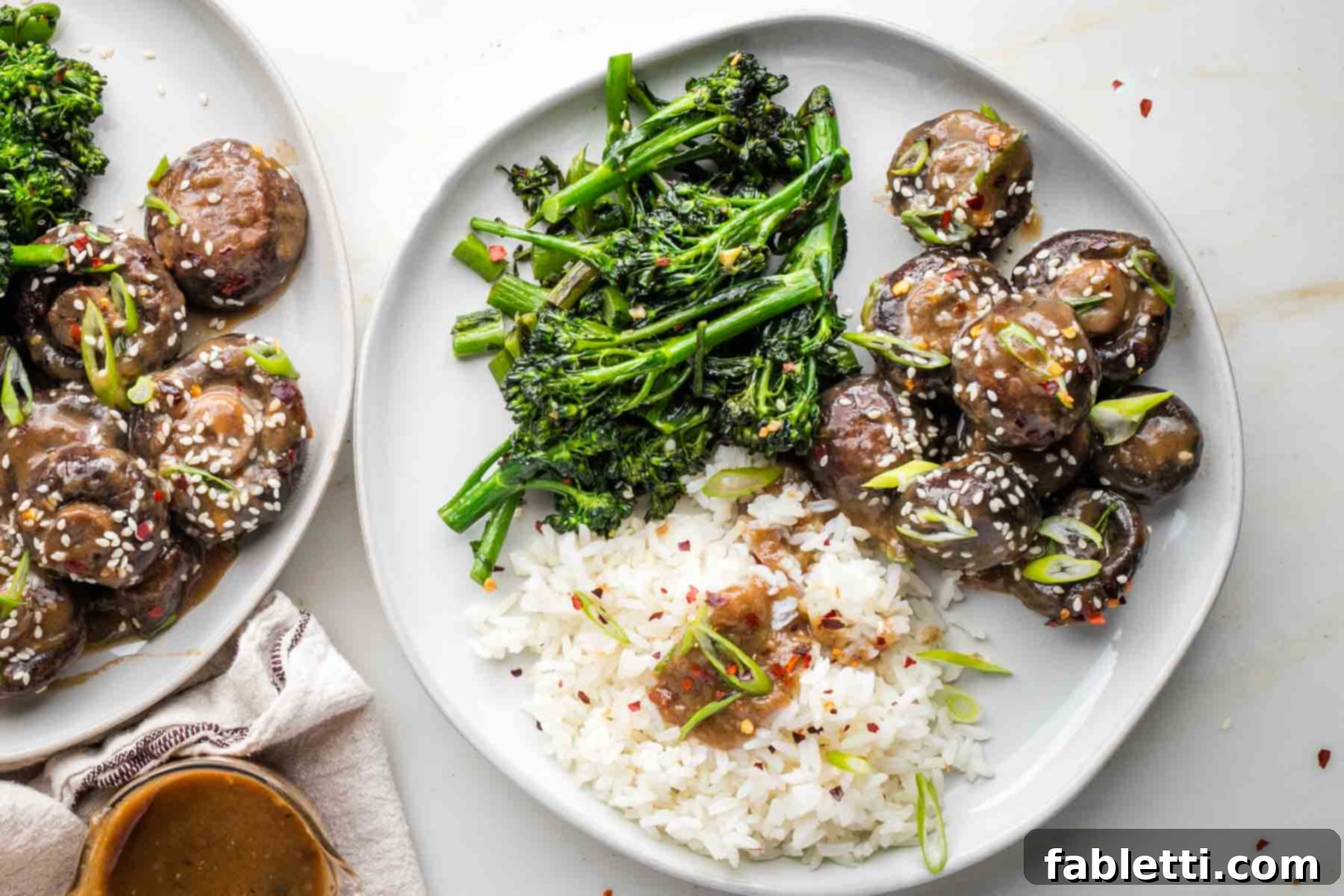
- Double the Miso Sauce: Your Future Self Will Thank You. This is perhaps the most crucial tip! The garlic miso sauce is so addictive, you’ll want it on everything. Doubling the recipe ensures you have plenty for drizzling over your main dish, grains, roasted vegetables, or even a simple salad. Trust me on this—make extra! Store any leftover sauce in an airtight container in the fridge for up to a week.
- Mind the Sodium: A Balanced Palate. Miso paste is naturally salty, providing ample seasoning for this dish. I rarely add soy sauce or additional salt because I find the miso’s sodium content sufficient. It’s always best to taste the finished dish before adding more salt. You can adjust it to suit your personal palate at the very end.
- Garnish for Impact: Flavor and Aesthetics. Don’t underestimate the power of a good garnish. A sprinkle of thinly sliced scallions (green onions) adds a fresh, subtle oniony bite and vibrant color. Toasted sesame seeds offer a lovely nutty crunch. For those who enjoy a touch of heat, a pinch of crushed red pepper flakes provides a welcome warmth. Fresh herbs like cilantro or finely chopped parsley can also brighten the overall profile.
- Versatility at Its Best: Side or Centerpiece. These Miso Mushrooms are incredibly versatile. They make a perfect vegan side dish, complementing almost any Asian-inspired meal or simple grain bowl. Alternatively, elevate them to the main dish centerpiece! Serve a generous portion with steamed rice and our recommended garlicky broccolini, as shown above, for a truly complete and delicious plant-based meal. They also pair wonderfully with quinoa, noodles, or even as a topping for polenta or toast.
- Even Browning is Key: Don’t Crowd the Pan. When cooking the mushrooms, avoid overcrowding the skillet. If you have too many mushrooms in the pan, they will steam instead of sear, leading to a less desirable texture. Cook them in batches if necessary, ensuring each mushroom has enough space to brown properly. This step is vital for developing that rich, caramelized flavor.
- Quality Miso Matters: Invest in Flavor. While any miso paste will work, investing in a good quality, traditionally fermented miso can significantly impact the depth and complexity of your sauce. Look for organic, unpasteurized varieties for the best probiotic benefits and flavor.
Storage and Reheating Instructions for Miso Mushrooms
Proper storage and reheating ensure your delicious Creamy Vegan Miso Mushrooms remain just as enjoyable days after preparation.
- Storing Cooked Mushrooms: Place any leftover miso glazed mushrooms in an airtight container and store them in the refrigerator. They will keep well for up to 5 days, making them excellent for meal prepping.
- Storing Extra Sauce: If you’ve wisely opted to double the sauce recipe, store the unused portion separately. Transfer it to a clean glass jar with a tight-fitting lid and keep it in the fridge. The sauce will remain fresh and flavorful for up to a week, ready to elevate other meals.
- Freezing Recommendations: I generally do not recommend freezing the cooked miso glazed mushrooms. The delicate texture of mushrooms can become a bit rubbery or soggy when defrosted, detracting from the overall experience. However, the miso sauce itself freezes beautifully! To freeze, pour the extra sauce into a freezer-safe container, leaving a little room at the top for expansion. It can be stored for up to 2-3 months. Thaw in the refrigerator overnight before reheating.
- Reheating: To reheat the miso mushrooms, transfer them to a saucepan or skillet. Warm gently over medium-low heat on the stovetop, stirring frequently, until they are heated through. This usually takes about 5 minutes. If the sauce seems too thick, you can add a tiny splash of water or vegetable broth to loosen it. Avoid high heat, which can cause the sauce to burn or the mushrooms to overcook.
Explore More Delicious Miso Recipes
Miso is an incredibly versatile ingredient that adds unparalleled depth and umami to a wide array of dishes. If you’ve fallen in love with the flavor in these Creamy Vegan Miso Mushrooms, you’ll be thrilled to discover more ways to incorporate this fermented superfood into your cooking. Here are some other easy and delicious miso-infused recipes to expand your culinary repertoire:
- White Bean and Escarole Soup Recipe
- Crispy Roasted Miso Potatoes
- Summer Slaw with Ginger Miso Dressing
- Vegan Yellow Split Pea Soup
Did you know commenting and rating recipes is one of the best ways to support your favorite food bloggers? If you made this recipe, please consider leaving a five-star rating below and a comment sharing your experience. Also, please share your photos on Instagram by tagging me @dkhealthcoach and using the hashtag #debraklein. Your feedback truly helps others discover and enjoy these recipes!
📖 Recipe: Creamy Vegan Miso Mushrooms
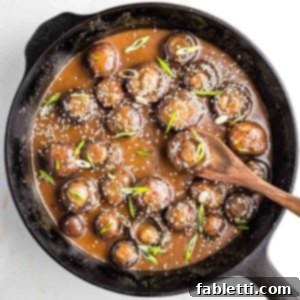
Miso Mushrooms
Author: Debra Klein
These Saucy Vegan Miso Mushrooms are rich and flavorful, satisfying and truly delicious. These Vegan Mushrooms are hearty and meaty, boasting an incredible garlic miso sauce that’s perfect for drizzling over rice or veggies, and exactly what’s needed to create the ultimate vegan buddha bowl.
Prep Time: 5 mins
Cook Time: 10 mins
Marinade Time: 15 mins
Total Time: 30 mins
Course: Main Course, Side Dish
Cuisine: American (with Japanese influences)
Servings: 4
Calories: 142 kcal
Equipment
- Microplane Zester
- Cast Iron Skillet
Ingredients
- 1 lb. Baby Bella Mushrooms (Cremini)
- 3 tbsp Light Miso Paste (white or yellow)
- 3 tbsp Unseasoned Rice Vinegar
- 2 tbsp Mirin
- 2 tbsp Toasted Sesame Oil
- 1 tbsp Maple Syrup
- 2 cloves Garlic, grated
- ¼ cup Water
Instructions
Make Miso Sauce
- Use a fork to thoroughly mix miso paste, rice vinegar, mirin, maple syrup, and toasted sesame oil in a small bowl. Grate garlic over the mixture and mix again until smooth and creamy.
Prepare and Cook Mushrooms
- With a damp paper towel, carefully brush off any dirt or debris from the mushrooms. Trim the dry ends of the stems. Place the cleaned mushrooms in a medium-sized bowl.
- Pour the prepared miso sauce over the mushrooms and gently mix to ensure everything is evenly coated. Let them sit to marinate for at least 15 minutes, stirring occasionally for maximum flavor absorption.
- Heat a cast iron or heavy skillet over medium-low heat. Using a slotted spoon, transfer the marinated mushrooms to the hot pan, allowing any excess marinade to remain in the bowl. Cook for about 2 minutes, stirring frequently. Spoon a bit of the leftover marinade over the mushrooms if the pan starts to look dry. The mushrooms will begin to release their natural juices.
- Add ¼ cup of water to the remaining marinade in the bowl and stir. Pour this diluted sauce over the cooking mushrooms. Continue to cook for another 5-7 minutes, tossing the mushrooms so they brown evenly and absorb the sauce. They will continue to shrink as they cook, becoming tender when pierced with a fork.
- Transfer the cooked mushrooms to a serving bowl or platter. Spoon any remaining rich miso sauce from the skillet over the mushrooms and serve warm.
Notes
- Double the Sauce: For extra miso sauce to drizzle over rice, grains, or other veggies, double the sauce recipe. Only spoon a bit of the leftover sauce into the pan over the mushrooms, and pour the rest into a gravy boat to serve alongside.
- Storage: Store cooked miso mushrooms in an airtight container in the fridge for up to a week. Extra sauce can be stored separately in a jar with a tight-fitting lid for up to a week. Reheat gently on the stovetop over medium-low heat.
- Optional Garnishes: Enhance your finished dish with a sprinkle of thinly sliced scallions, toasted sesame seeds, or a pinch of crushed red pepper flakes for an added layer of flavor and texture.
Nutrition
- Calories: 142 kcal
- Carbohydrates: 15 g
- Protein: 5 g
- Fat: 8 g
- Saturated Fat: 1 g
- Polyunsaturated Fat: 3 g
- Monounsaturated Fat: 3 g
- Sodium: 549 mg
- Potassium: 552 mg
- Fiber: 1 g
- Sugar: 8 g
- Vitamin A: 11 IU
- Vitamin C: 0.5 mg
- Calcium: 37 mg
- Iron: 1 mg
The nutrition calculations were done using online tools. To obtain the most accurate representation of the nutritional information in any given recipe, you should calculate the nutritional information with the actual ingredients you used. You are ultimately responsible for ensuring that any nutritional information is accurate, complete and useful.
Did you make this recipe?
Please leave a review below, then snap a picture and tag me @dkhealthcoach or use hashtag #dkhealtcoach on Instagram so I can see it!!
